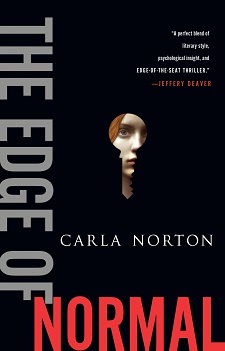
Carla Norton’s first foray into fiction, The Edge of Normal, is an enthralling novel about a young woman rebuilding her life after being held captive for years. But there is more than a ripped from the headlines pastiche as Norton delivers an emotional story of a woman fighting to regain her sense of self, to reach, at least, an edge of normal.
In telling the story of Reeve LeClaire, who was kidnaped when she was 12 and held for four years, the author shows a heartfelt view of victims who, even after they have been rescued, become subjects to be exploited by psychologists and lawyers on documentaries and news shows.
During a recent interview, Norton gave us some insight about The Edge of Normal and the story behind her novel.
Q: Did the discovery of Gina DeJesus, Michelle Knight and Amanda Berry rescued years after they disappeared influence you?
A: My novel was already complete when that case hit the news, but the story certainly made my blood boil. I almost immediately sat down to write a hotheaded essay titled, “How can the Punishment fit the Crime?”
Q: How did you come up with the rituals and routines that Reeve has devised as part of her recovery?
A: In writing fiction, you inhabit your characters, and I confess that her quirks are partly mine. A lot of her defensiveness and her neuroses are just exaggerations of my inner self. Also, I have a scar at the back of my neck, and I have a problem with numbness in my left hand, so Reeve inherited those from me.
Q: This must be a new field. Did you encounter any resistance when researching the subject?
A: People have been generous about sharing information. I’m encountering more resistance in researching the sequel than I did in researching The Edge of Normal, but I can’t go into that.
And this field isn’t really new. It goes all the way back to the ancient myth of Persephone, who was abducted by Hades and taken to the Underworld.
Q: What myths do you hope The Edge of Normal might dispel about prolonged captivity?
A: I had no agenda other than to present a compelling story. But my heroine is rooted in reality, and in one scene she gets angry about the misconception that captives fall in love with their captors.
Q: You've written about this subject before in your nonfiction Perfect Victim: The True Story of the Girl in the Box. Are the myths about prolonged captivity being dispelled?
A: Patty Hearst once said, “When you are held captive, people somehow expect you to spit in your captor’s face and get killed.” That’s less true today. I think public understanding of Stockholm syndrome has evolved. But you’ll recall that Patty Hearst didn’t meet with much public sympathy. Neither did Colleen Stan [Perfect Victim], who was held in a horrific situation for seven years. People didn’t understand why victims didn’t escape at the first opportunity. But perceptions started to shift with Elizabeth Smart’s rescue, partly because she was a child when she was taken, and partly because the media began to take a closer look at captivity syndromes.
Q: Where did we get the term “Stockholm syndrome?”
A: A Stockholm bank robbery in 1973 led a Swedish criminologist to coin that phrase. Hostages were taken and held five days—that’s all—but began to exhibit unexpected sympathy toward their captors. You can see the same psychological effects in many types of captive situations. POWs and hostages exhibit similar symptoms. It’s a survival mechanism. The opposite, I learned recently, is called “London syndrome,” based on a case in which hostages fought back and were killed.
Q: What is the biggest obstacle in the recovery of these victims?
A: I’m not a psychologist, and each individual faces unique problems, but it depends largely on the duration and severity of their ordeal. Having a supportive family is a huge factor in being able to feel safe and in control again. It’s a long road of both physical and mental healing. Just imagine going without any medical or dental care while being abused and tortured and starved. These victims can also suffer long-term effects from being deprived basic things like vitamins and sunshine. It makes me furious to think about it.

Q: As much as she tries, Reeve isn’t quite back to normal, is she?
A: She never will be, but that is her strength. She has endured so much that she has an underlying toughness. She’s damaged but uniquely courageous, perhaps a bit like Lisbeth Salander. Because I wasn’t interested in a protagonist whose strength comes from training, or who is duty-bound to fight crime. Reeve isn’t a cop or a spy. She’s driven by her inner demons.
Q: You vividly show how the victims’ ordeals never seem to end but are rehashed by lawyers, the media and pop psychologists; why did you want to portray this kind of intrusion?
A: Every time one of these cases hits the news, I sit there tearing out my hair because of the inane coverage. I’m one of those crazy people who argues with the television.
Q: Is Reeve’s psychiatrist, the compassionate Ezra Lerner, based on anyone?
A: He’s roughly based on Dr. Chris Hatcher, who testified as an expert witness in Cameron Hooker’s trial, along with a mix of other doctors I’ve known, very compassionate, brilliant men. There’s also a bit of Jonathan Kellerman’s Dr. Alex Delaware, plus a touch of the child psychologist portrayed by Bruce Willis in The Sixth Sense.
Q: Why was Perfect Victim put on the reading list for the FBI’s Behavioral Sciences Unit?
A: That came as a complete surprise to me. I should probably credit the prosecutor, my coauthor, Christine McGuire, who spoke to the FBI. This was a textbook case of Stockholm syndrome, and the whole trial hinged on volition, on the idea that the victim’s psychological chains prevented her escape.
Q: In your research about prolonged captivity, what was the most horrifying thing you learned?
A: The captors are such twisted human beings. Kidnapping and holding a person captive is an extremely taxing endeavor. Who chooses to dedicate their lives to that? It’s ghastly.
Q: Are you still in touch with Colleen Stan, the woman who endured the events recounted in Perfect Victim?
A: Yes, I’m happy to have Colleen as a friend. She has been working on a memoir, which I hope she’ll get published. She’s had an extraordinary life and she’s an amazingly resilient person. So let’s be clear that she’s now a survivor, not a victim.
Q: Why is the book titled Perfect Victim. What made her perfect?
A: If Colleen had not behaved perfectly, there’s no question in my mind that she would have been killed. The title refers to a young, trusting woman, hitchhiking alone. For a kidnapper, that’s a perfect situation. (True confession: I hitchhiked that same stretch of freeway when I was about her age. Very stupid of me, I know.)
Q: Was The Edge of Normal a difficult novel to tackle?
A: Yes, in some ways, because I needed to convey what Reeve had endured, without sensationalizing it or making it too graphic. You want to suggest the months and years of being locked up, the terrible abuse, without making the reader suffer for years in a basement.
Q: Who do you read?
A: Many wonderful writers. Right now I’m reading John Lescroart. Other favorites are Laura Lippman, Robert Crais, Jeffery Deaver, Jo Nesbo, Steig Larsson, Patricia Highsmith, and Lee Child. And in other genres, Barbara Kingsolver, David Benioff, Karen Engelmann, Suzanne Collins … the list goes on and on, and I’ve barely scratched the surface.
Q: Is there one book, fiction or nonfiction, that inspired you?
A: The Silence of the Lambs stands out. It’s a brilliant thriller, not only because of the plot, but because of the characters and the prose. I’m indebted to Thomas Harris for creating Clarice Starling, who was whispering in my ear whenever Reeve faced danger.
But there are other novels that deserve kudos, too.
Q: Which other novels?
A: The Collector, by John Fowles, because he so vividly portrayed the psychology of both sides of the captive equation in 1963, even before the term “Stockholm syndrome” was coined. In some ways, Room, by Emma Donoghue is a pioneering book, and so is Misery, by Stephen King, which was published in 1988.
Q: You worked as a journalist for years; how did journalism affect your career as an author?
A: I’m a terrible hoarder of information. There’s a journalistic axiom that, when you start hearing the same things over and over, you know your research is done. And there’s another saying that, just because you know something, your reader doesn’t have to. In other words, don’t cram every item into your story just to show off how hard you’ve worked. Each fact must serve the story.
And that’s true in both fiction and nonfiction. You don’t want to weigh down the story with a lot of exposition.
Q: What are some of the things you researched that didn’t fit into this book?
A: I did a comparison of three particular cases, Colleen Stan, Elizabeth Smart, and Jaycee Dugard, who were each kidnapped by a husband and wife team. That’s a pretty unusual dynamic, and I think there are many interesting parallels in the types of coercion employed. But for my novel, I was more interested in a lone wolf type predator.
Q: What’s the biggest difference in writing crime fiction vs. writing true crime?
A: In fiction, the villains can get what they deserve without legal representation and without due process. The punishment can exactly fit the crime.
Q: How does this inspire your fiction?
A: Reeve, my protagonist, has done similar research, reading all kinds of academic journals, trying to get a grasp on what happened to her.


